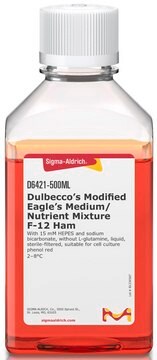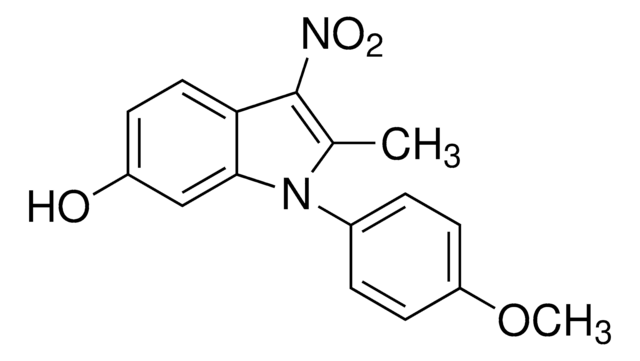Wichtige Dokumente
D0547
Dulbecco Modifiziertes Eagle-Medium/Nährstoffmischung F-12 Ham
With L-glutamine and trace elements, without HEPES and sodium bicarbonate, powder, suitable for cell culture
Synonym(e):
DME/F-12, 1:1 Mischung
About This Item
Empfohlene Produkte
Qualitätsniveau
Form
powder
Methode(n)
cell culture | mammalian: suitable
Komponenten
NaHCO3: no
sodium pyruvate: 0.11 g/L
HEPES: no
phenol red: yes
glucose: 3.15 g/L
L-glutamine: yes
Versandbedingung
ambient
Lagertemp.
2-8°C
Suchen Sie nach ähnlichen Produkten? Aufrufen Leitfaden zum Produktvergleich
Allgemeine Beschreibung
Anwendung
- to culture cerebral cortices from mice embryos
- as a component of the human corneal epithelium (HCE) media for culturing human limbal explants
- to culture human corneal epithelial cell lines
Sonstige Hinweise
Menge
Rekonstituierung
Ergänzung
auch häufig zusammen mit diesem Produkt gekauft
Analysenzertifikate (COA)
Suchen Sie nach Analysenzertifikate (COA), indem Sie die Lot-/Chargennummer des Produkts eingeben. Lot- und Chargennummern sind auf dem Produktetikett hinter den Wörtern ‘Lot’ oder ‘Batch’ (Lot oder Charge) zu finden.
Besitzen Sie dieses Produkt bereits?
In der Dokumentenbibliothek finden Sie die Dokumentation zu den Produkten, die Sie kürzlich erworben haben.
Kunden haben sich ebenfalls angesehen
Unser Team von Wissenschaftlern verfügt über Erfahrung in allen Forschungsbereichen einschließlich Life Science, Materialwissenschaften, chemischer Synthese, Chromatographie, Analytik und vielen mehr..
Setzen Sie sich mit dem technischen Dienst in Verbindung.







